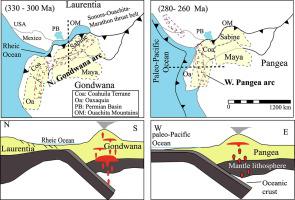Gondwana Research ( IF 6.1 ) Pub Date : 2022-07-11 , DOI: 10.1016/j.gr.2022.07.003 Hepeng Tian , Majie Fan , Victor A. Valencia , Kevin Chamberlain , Lowell Waite , Robert J. Stern , Matthew Loocke

|
Early Permian arc magmatism is critical to understanding the final assembly of the supercontinent Pangea and subsequent plate reorganization. Here we report the geochronology and geochemistry of Cisuralian and Guadalupian volcanic tuffs in southwestern Laurentia and infer the magmatic sources and plate reorganization related to Laurentia-Gondwana collision. Zircon CA-ID-TIMS U-Pb dates of tuffs in the Wolfcamp B, Wolfcamp A and lower Spraberry units in the Permian Basin provide the first set of absolute ages of Cisuralian deposits in this basin. Zircon geochemistry data further show that the parent melts of these tuffs were granitic melts that formed in continental arcs. Syn-depositional zircons from the Wolfcamp B tuff beds (288.2 ± 1.7 Ma) have an average εHf value of +5.5 and TDM2 model ages between 675 and 1207 Ma, reflecting a mixture of juvenile mantle melts and Precambrian crust. The isotopic signature is consistent with Mississippian Laurentian tuffs derived from a northern Gondwana arc formed by the subduction of the Rheic oceanic plate. However, zircons from a Wolfcamp A tuff bed (287.2 ± 0.5 Ma) show an average εHf value of −4.5, much more evolved than the inferred northern Gondwana arc, but consistent with granitoids of similar or younger age in the Oaxaquia terrane. This change in εHf most likely reflects magmatism related to subduction of a paleo-Pacific oceanic plate beneath western Pangea. Our interpretation suggests a late Cisuralian plate reorganization that was caused by plate reorganization following Pangea assembly led to rapid (∼1 Myr) initiation of subduction beneath western Pangea. This study also compares tuff dates from LA-ICPMS and CA-ID-TIMS U-Pb dating and concludes that the weighted mean date of the youngest dominant KDE mode (WMYDM) is the best way to approximate LA-ICPMS dates to true depositional ages.
中文翻译:

Laurentia 板块边缘的早二叠世快速构造重组:来自美国二叠纪盆地火山凝灰岩的证据
早二叠纪弧岩浆作用对于理解超大陆盘古大陆的最终组装和随后的板块重组至关重要。在这里,我们报告了劳伦西亚西南部和瓜达卢皮火山凝灰岩的年代学和地球化学,并推断了劳伦西亚-冈瓦纳碰撞相关的岩浆来源和板块重组。二叠纪盆地 Wolfcamp B、Wolfcamp A 和下 Spraberry 单元凝灰岩的锆石 CA-ID-TIMS U-Pb 年代提供了该盆地 Cisuralian 沉积物的第一组绝对年龄。锆石地球化学数据进一步表明,这些凝灰岩的母体熔体是在大陆弧中形成的花岗岩熔体。来自 Wolfcamp B 凝灰岩层 (288.2 ± 1.7 Ma) 的同沉积锆石的平均 ε Hf值为 +5.5 和 T DM2模型年龄在 675 到 1207 Ma 之间,反映了幼年地幔熔体和前寒武纪地壳的混合物。同位素特征与密西西比州劳伦斯凝灰岩相一致,这些凝灰岩源自由莱克洋板块俯冲形成的北冈瓦纳弧。然而,来自 Wolfcamp A 凝灰岩床 (287.2 ± 0.5 Ma) 的锆石显示平均 ε Hf值为 -4.5,比推断的北冈瓦纳弧进化得多,但与 Oaxaquia 地体中类似或更年轻的花岗岩相一致。ε Hf的这种变化很可能反映了与西盘古大陆下方古太平洋海洋板块俯冲有关的岩浆作用。我们的解释表明,由盘古大陆组装后的板块重组引起的晚期 Cisuralian 板块重组导致西部盘古大陆下方快速(~1 Myr)开始俯冲。本研究还比较了来自 LA-ICPMS 和 CA-ID-TIMS U-Pb 测年的凝灰岩年代,并得出结论,最年轻的主导 KDE 模式 (WMYDM) 的加权平均年代是将 LA-ICPMS 年代近似为真实沉积年龄的最佳方法.



























 京公网安备 11010802027423号
京公网安备 11010802027423号